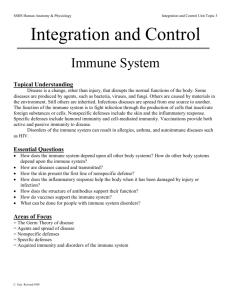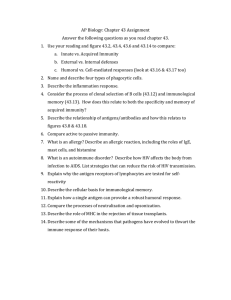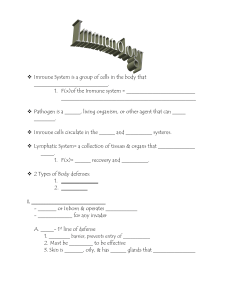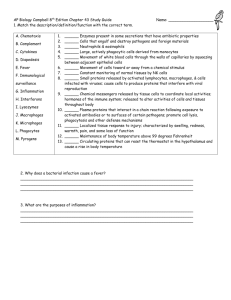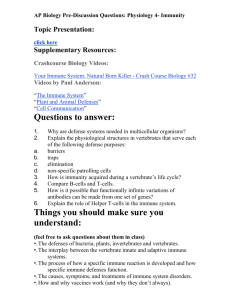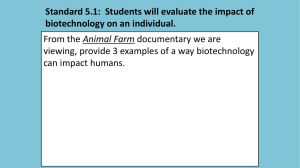Body Defenses: Nonspecific vs. Specific Mechanisms
advertisement
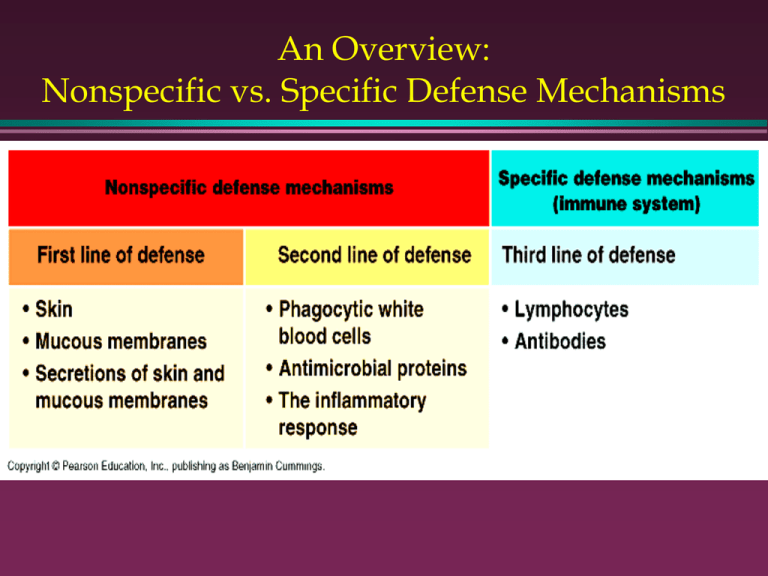
An Overview: Nonspecific vs. Specific Defense Mechanisms Body Defenses: An Overview Nonspecific Defenses •Hinder entry of most pathogens (disease causing organisms) •Prevent spread of disease •Strengthen immune response Body Defenses: An Overview Specific Defenses: The Immune System » Destroys foreign cells that cause disease » Recognize self from non-self » Inactivate toxins and other foreign chemicals Nonspecific Response Surface Barriers: 1st line of defense 1. 2. Intact Skin (epidermis) » Forms mechanical barrier » Acid secretion inhibits bacterial growth » Keratin provides resistance against bacterial enzymes, acids, bases Mucus membranes » Trap microorganisms in respiratory and digestive tracts Electron Micrograph of Escherichia coli with Pili E. coli can cause urinary tract infections and traveler's diarrhea Flushing Away of Bacteria Lacking Pili • Lacking any means of adherence, urine typically flushes bacteria from the urethra. http://www.cat.cc.md.us/c ourses/bio141/lecguid e/unit1/bacpath/pili/n opili.html Bacterial fight back! Bacteria with Pili Resisting Flushing 1. Bacteria such as Neisseria gonorrhoeae use pili to adhere to the mucous membranes of the urethra and thus resist the flushing action of the urine. http://www.cat.cc.md.us/co urses/bio141/lecguide/ unit1/bacpath/pili/yesp ili.html Bacterial fight back! Salmonella Invading an Intestinal Mucosal Epithelial Cell • • • • Salmonella adheres to the microvilli of intestinal mucosal epithelial cells. Triggers pseudopods that engulf the Salmonella and place it in a vacuole. Salmonella replicate within the vacuole and are subsequently released from the cell. http://www.cat.cc.md.us/course s/bio141/lecguide/unit1/bacpat h/salinv.html Nonspecific Response 1st line of defense (cont.) 1. 2. 3. 4. 5. Gastric juice kills pathogens Acid lining of vagina kills pathogens Tears & saliva » Contain lysozyme kills pathogens Nasal hairs » Filter and trap microorganisms Cilia propel mucus away from lower respiratory tract First-line respiratory defenses 2nd line of Nonspecific defense: Nonspecific cellular defenses 1. 2. Phagocytes: macrophages & neutrophils » Feed on pathogens that penetrate membrane barriers » Display antigen to enhance immune response (specific response) Natural killer cells » Lyse and kill cancerous and virally infected cells NK Cell destroying a target cell Phagocytosis by a Macrophage Phagocytosis Animation http://www.whfreeman.com/immunology/CH01/phagocytosis.htm Phagocytosis Animation by Cells Alive: http://www.cellsalive.com • How to get to the animation 1. 2. 3. 4. Click on “Immunology” Click on “Ouch—anatomy of a splinter” Go to bottom of page and Click on “Next” Click on “Phagocytosis—how white cells eat microbes” 2nd line of Nonspecific defense: Nonspecific chemical defenses Inflammatory response 1. Prevents spread of damaging agents 2. Removes cell debris and pathogens 3. Aids in tissue repair 4. Triggered when tissues are damaged or irritated • Physical trauma, heat, chemicals, pathogens Inflammatory Response: a simplified view Animation of Inflammatory Response http://www.whfreeman.com/immunology/CH01/diapedesis.htm Inflammatory Response (cont.) • Cardinal signs: Redness, heat, swelling, pain • Sequence of events 1. 2. 3. 4. 5. 6. Damaged tissue Histamine & kinins Vasodilatation + capillaries become leaky Edema (swelling) Pain receptors activated WBC’s (B & T cells + phagocytes) attracted Inflammatory Response: a detailed view Nonspecific chemical defenses (2nd line of Nonspecific defense) Anti-microbial Chemicals 1. Complement protein system • More than 20 plasma proteins • Produced by the liver • Inactive until contact with pathogen Roles a. Enhance inflammatory response – Vasodilatation – Attract phagocytes Roles of Complement Protein System (cont.) Lyse foreign cells b. • Poke holes in membrane water enters cells burst Opsonisation c. Cause foreign cells to stick together • Yummy for phagocytes enhances phagocytosis • Animation of Phagocytosis Enhanced by Opsonization http://www.ca t.cc.md.us/ courses/bi o141/lecgui de/unit1/b acpath/pha gocytosis/p hagsum.ht ml Bacterial fight back! Bacterial Resistant to Phagocytosis In some bacteria, a capsule covers the opsonin C3b on bacterial cell wall 2. Prevents binding to C3b receptors on the surface of phagocytes: http://www.cat.cc.md.us/ courses/bio141/lecg uide/unit1/bacpath/c apc3b.html 1. Bacterial fight back! Bacillus anthracis in Action: Inhalation Anthrax Source: Scientific American (March 2002) 1. Macrophage cells ingest B. anthracis spores and carry them to lymph nodes • 2. 3. In blood and inside macrophage: Spores transform into actively dividing cells Proliferating B. anthracis cells erupt from macrophage cells How B. anthracis cells evades destruction • • Produce capsule that protects them from digestion by macrophages and antibodies from B-cells Produce toxin enters and that impairs immune cell function Bacterial fight back! Blocking Phagosome Formation by Depolymerizing Actin 1. Some bacteria secrete proteins which depolymerize the phagocyte's actin microfilaments used for phagocytic engulfment. http://www.cat.cc.md.us/cour ses/bio141/lecguide/unit 1/bacpath/actinan.html Anti-microbial Chemicals (Cont.) 2. Interferons » Released by virally infected cells » Stimulate neighboring cells to produce anti-viral proteins (AVP) » AVP’s inhibit viral reproduction in nearby cells Interferons Anti-microbial Chemicals (Cont.) 3. Pyrogens » Secreted by macrophages » Cause mild fever Slows down bacterial reproduction The 3rd Line of Defense: Specific Defense Mechanisms 1. The immune response a. Functional system that seeks to destroy or inactivate specific antigens (foreign molecules and cells) b. Antigen specific: responds to particular foreign substances c. Systemic response: body wide response d. Memory: quicker and stronger response to previously encountered pathogens Branches Of The Immune System 1. Humoral immunity » 2. Where B-cells circulating in the body’s fluids produce antibodies in response to a particular antigen Cell-mediated immunity » Where killer T-cells (cytotoxic T-cells) destroy – cancer cells – virus and bacteria infected cells – cells of foreign grafts Humoral and Cell-mediated Immunity Immune Response: Roles of Cells involved Macrophages 1. » » » Antigen presenter (APC = Antigen Presenting Cell) Activate Helper T Cells (by contact w/ displayed antigen) Releases cytokines: Enhances Helper T Cell activation Helper T Cells 2. » » » Stimulate the humoral and cell-mediated response against specific antigens Activated by Macrophages (Cytokines and contact w/ presented antigen) Activate B-Cells and Killer T-cells by secreting cytokines Humoral Immunity 1. B lymphocytes (B-cells) 2. • Produced and mature in the bone marrow • Mature = become immunocompetent = ability to respond to an antigen by binding to it B cells that bind to self-antigens are destroyed Move to and concentrate in lymphatic tissue Produce antibodies specific for specific antigens » Plasma cells vs. memory cells 3. 4. Humoral Immunity Clonal Selection Theory Antibody Structure: Y-shaped molecules Each Antibody binds to a specific Epitope Each Antibody binds to a specific Epitope Major Antibody Types and their functions • IgM first to be made, good opsonizer and complement fixer • IgA Found in secretions: e.g. mucous and milk • IgG most abundant in blood, goes to fetus, good opsonizer and OK complement fixer, helps NK cells kill • IgE Causes allergies, hypersensitivities and anaphylactic shock; Defends against parasites Mechanism of Antibody Action Complement Protein-Ab interaction Results in Cell Lysis 1st and 2nd Exposures to a Specific Antigen T Lymphocytes (T-Cells) 1. 2. 3. 4. Produced in bone marrow » Multiply & mature in thymus gland (takes 2-3 days to become immunocompetent) T-cells that bind to self-antigens are destroyed Move to and concentrate in lymphatic tissue Kinds of T-cells » Killer T-cells, helper T-cells, memory cells, suppressor T-cells Development of Lymphocytes Lymphatic System • • • Returns tissue fluid that has escaped the circulatory system back to the blood Lymph nodes filter out antigens from the lymph fluid Lymphocytes concentrate/reproduce in the lymph nodes, especially during infections Lymph Node: Filters Lymph Killer T-Cell Activation requires: 1. Specific Prekiller T-Cell binds to target cell 2. Cytokines secreted by Helper T-Cell 3. Helper T-Cell secretes cytokines after interacting with AP (macrophage) Cytotoxic T-Cell inducing Apoptosis in Target Cell • The binding of a Cytotoxic T-cell to the specific receptor molecules in a target cell may activate processes that lead to apoptosis: programmed cell suicide. Cytotoxic T-Cell Lysing a Cell by Secreting Perforin Animation of Cytotoxic T-Cell Lysing a Cell http://www.cellsalive.com/ctl.htm Active Immunity Active Immunity • Naturally acquired during infections. How? • Artificially acquired by vaccines –Vaccines contain dead or attenuated (weakened) organisms that stimulate the immune response –Booster Shots...Why needed? Humoral and Cell-mediated Immunity Passive Immunity Passive Immunity •Antibodies obtained from outside source •Effect is short term (2-3 weeks)—why? •Examples –Via placenta and mother’s milk – Via injections: Gamma globulin Anti-venoms Anti-toxins (botulism, rabies, tetanus) Disorders of the Immune System Allergies (Hypersensitivities) 1. • Immune Response against harmless antigens called Allergens – Results in damage to various body tissues Major Types of Allergies 2. • Immediate or Acute Hypersensitivity – Most common; Localized Reaction in Seconds – Plasma cells release IgE in response to allergen – IgE stimulates mast cells to release histamine • Blood vessels dilate and leak, causing... » Runny nose, watery eyes, itching, hives Allergic Response 1. Allergen stimulates Ab production (humoral immunity) 2. Ab binds to and sensitizes mast cell 3. Binding of allergen to mast cell stimulates release of histamine 4. Histamine results in inflammatory response Disorders of the Immune System (cont.): Anaphylactic Shock 1. Systemic Allergic Response to an allergen that enters directly into the blood » Bee and ant stings, spider and snake bites » Injection of foreign substance: Penicillin, drugs, foreign proteins, mismatched blood types, etc. 2. Allergen circulates quickly through entire body causing death in minutes » Rapid Drop in Blood Pressure...Why? » Constriction of air passages (bronchioles) in lungs makes breathing difficult » Treat with epinephrine Disorders of the Immune System (cont.): Delayed Hypersensitivities 1. 2. Allergic contact Dermatitis » Most common type » Direct skin contact with... – Poison oak/ivy, heavy metals (e.g. Pb, Hg, Ba, etc.), misc. chemicals in cosmetics, deodorants, foods, etc. – 1-3 days to respond Symptoms are caused by lymphokines released by Killer T Cells » Treat with corticosteroid drugs (e.g. cortisone) » Why won’t antihistamines work? Disorders of the Immune System (cont.): Autoimmune Diseases 1. 2. Killer T Cells or Antibodies attack the body’s own tissues as if they were foreign Possible Causes.. a. B and T Cells that attack self are not eliminated after they are produced b. Appearance of new self proteins/antigens – Possibly due to mutations , or – Bacterial or viral modification of self -proteins c. Cross-reaction of Antibodies or Killer T Cells produced during infection against self Disorders of the Immune System (cont.): AIDS: Acquired Immunodeficiency Syndrome HIV HIV HIV HIV from Cells Alive Go to the computer lab and study Human Immunodeficiency Virus (HIV) Infection at the Cells Alive website: http://www.cellsalive.com Once at the website • Click on Immunology from the menu on the left • Then click HIV infection • HIV Infects and Kills Helper T-Cells • What effect will this have on each of the following. Explain your reasoning. a. b. c. d. e. f. g. Macrophage activity Humoral Immunity Cell-mediated Immunity Complement protein activity NK Cells Inflammatory response Interferon activity Case Study Questions • • Now is your chance to test your knowledge of the human immune system. Answer the following 11 case studies in as much depth and detail as your knowledge allows. Case Study Question 1 Humoral and Cell-Mediated Immunity • An individual failed to develop a thymus gland because of a genetic defect, what would happen to humoral and cellmediated immunity? Case Study Question 2 Nonspecific Defenses a. b. What abnormalities would a person have that has a neutrophil deficiency? A person with a macrophage deficiency? Case Study Question 3 Nonspecific and Specific Defenses • AIDS patients have a low helper T cell count. Would you expect patients with AIDS to develop fever in response to an infection? Case Study Question 4 Specific Defenses • A patient with symptoms of hyperthyroidism is found to have circulating antibodies that attack the receptors for TSH (thyroid stimulating hormone). What is the cause of hyperthyroidism in this patient? » Background Information: The thyroid gland produces thyroxin in response to a TSH, a hormone released by the pituitary gland. The binding of TSH to TSH receptors located on the cells of the thyroid stimulate it to release thyroxin, a hormone that helps to regulate the bodies metabolic rate. Hyperthyroidism involves elevated secretion of thyroxin and, hence, an elevated rate of metabolism. Case Study Question 5 Specific Defenses • If the thymus gland of an experimental animal is removed immediately following birth, the animal exhibits the following characteristics: » High susceptibility to infection » Decreased numbers of lymphocytes » Ability to reject graphs is reduced • Explain these observations. Case Study Question 6 Specific Defenses • • Background Information: Tetanus is caused by bacteria that enter the body through wounds in the skin. The bacteria produce and release a toxin that causes spastic muscle contractions. Death often results from the failure of the respiratory muscles. A patient comes to the emergency room after stepping on a nail. If the patient has been vaccinated against tetanus, the patient is given a tetanus booster shot, which consists of the toxin in an altered so that it is harmless. If the patient has never been vaccinated against tetanus, the patient is given an antiserum shot against tetanus toxin. Explain the rationale behind these treatments. Case Study Question 7 Specific Defenses • In reference to case study question 6: Sometimes both a booster shot and antiserum shot are given, but at different locations in the body. Explain why this is done, and why the shots are given in different locations. Case Study Question 8 • In some cases, a booster shot is used as part of a vaccination procedure. A booster shot is another dose of the original vaccine given some time after the original dose was administered. Why are booster shots given? Case Study Question 9 • Some people with a deficit of IgA, immunoglobulin A, have chronic sinus infections and respiratory tract infections. Explain these symptoms. Case Study Question 10 • A few days after a walk in the hills you develop a severely itchy rash. What’s happening and what is the method of treatment? Case Study Question 11 • Minutes after walking into a carpet showroom you begin suffering from symptoms of asthma (constrictions of the passages of the respiratory system which make breathing difficult) What’s happening and what is the method of treatment? Explain fully.
